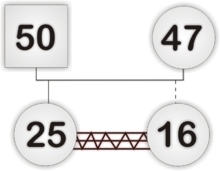Genogram
A genogram ( suitcase word from genealogy and diagram ) is a form of representation of family relationships , which is mainly used in systemic family therapy to represent and evaluate family relationships , recurring constellations and medical history ; In terms of content, it goes far beyond a family tree. A genogram is used to visualize behavior patterns, relationship-determining psychological factors and behavior patterns that are repeated within a family and then analyze them.
In a broader sense, genograms or the schematization based on them are also used beyond family connections, for example for social network analysis , in order to illustrate connections, connections and lines of conflict in a very wide range of topics up to the global interdependence of business and politics .
development
Monica McGoldrick and Randy Gerson, who published the book Genograms: Assessment and Intervention in 1985, pioneered today's genogram work . Genograms are used in family research , medicine , psychology , psychiatry , education and social pedagogy . Family counselors used genograms to analyze problems.
Patterns similar to the genograms were used in Germany during the Nazi dictatorship for “racial issues”, supposedly inherited character traits, disabilities or addiction to drugs.
presentation
Genograms are made up of simple symbols arranged like a family tree. A symbol stands for a family member. The symbols indicate gender and, with different lines, the relationship with the family. For example, adopted children and pets have a dashed line, and foster children have a dotted line. Usually the date of birth (and possibly the date of death) is above the symbol, and the name below it. Inside the symbol is the age or various symbols that indicate, for example, hereditary diseases , marriage-like communities, stillbirths, abortions and sudden infant deaths. Genograms are traditionally drawn by the counselor or therapist. There is also the possibility that the clients make their own drawing. This visualization offers additional possibilities for the formation of hypotheses.
content

A genogram not only records names and dates of birth, but also how they relate to each other. For example, career data, intra-family conflicts, illnesses and habits can be displayed.
One advantage is that different types of relationships can be represented in different colors in genograms, such as married, divorced, separated, unmarried and engaged couples.
Usually, genograms also contain representations of feelings for one another. For example, two parallel, horizontal green lines between two people stand for friendship, two green, interlocking circles mean love. Red lines mostly represent negative relationships like hate, suspicion, and rejection.
In order to include people such as neighbors, employees or classmates, superiors or teachers, pastors and the like, these are sometimes also incorporated into the genogram. For example, genograms can also be created for companies.
application
In family research , genograms are used to record the lives of family members. This can result in very complex family trees showing marriages and divorces, adoptions and other family structures. This enables genealogists to analyze interesting facts such as name clusters, sibling rivalries or even historical events such as migrations .
In medicine, health relationships, for example cancer risks and above all hereditary diseases , can be shown with the help of genograms . With this knowledge, more precise medical analyzes can be worked out. In addition, health risks can be discovered in this way.
Psychologists use genograms in order to obtain essential information and thus to better advise or treat the patient . For example, you can quickly identify conflicts and use this as a basis to evaluate the patient's behavior.
Social workers can use genograms to identify and evaluate emotional ties between family members and other people in their social environment. This shows, for example, the cohesion of the family.
Using genograms, researchers can show and understand processes between many generations. Genograms are also developed for plant and animal species. In addition, different mechanisms and tactics, for example for survival or hunting, can be identified. In addition, social structures within herds can be researched.
In education, genograms are used to discuss books and represent families of famous people. Special details can also be worked out using genograms.
literature
- Monica McGoldrick et al. a .: Genograms in family counseling. 3. Edition. Verlag Hans Huber, Bern 2009, ISBN 978-3-456-84647-7 .
- Bernd Roedel: Practice of genogram work. 6th edition. Modern learning publishing house, Dortmund 2010, ISBN 978-3-86145-308-6 .
- Stuart Lieberman: Transgenerational Family Therapy. 1st edition. Croom Helm Ltd., London 1979, ISBN 978-0-85664-776-5 .
- E. Sperling, A. Massing, G. Reich et al. a .: The multigenerational family therapy. Vandenhoeck & Ruprecht, Göttingen 1982, ISBN 978-3-525-45740-5 .
- Jürgen Beushausen: Genogram and network analysis. The visualization of family and social structures. Vandenhoeck & Ruprecht, Göttingen 2012, ISBN 978-3-525-40183-5 .
- Ruthard Stachowske : Multi-generation therapy and genograms in drug help - drug addiction and family history . Asanger Verlag, Heidelberg / Kröning 2002, ISBN 978-3-89334-379-9 . Ruthard Stachowske Retrieved May 21, 2014.
Web links
- Helmut Johnson: The genogram in systemic personality analysis ; Article for the systemic therapy journal Mensch und System , August 1995 (PDF file)
- Making family ties visible - working with the genogram (PDF file)
- "Genogram Designer"
- WinGeno, a computer program for the graphic representation of family constellations in the form of a genogram (English)

